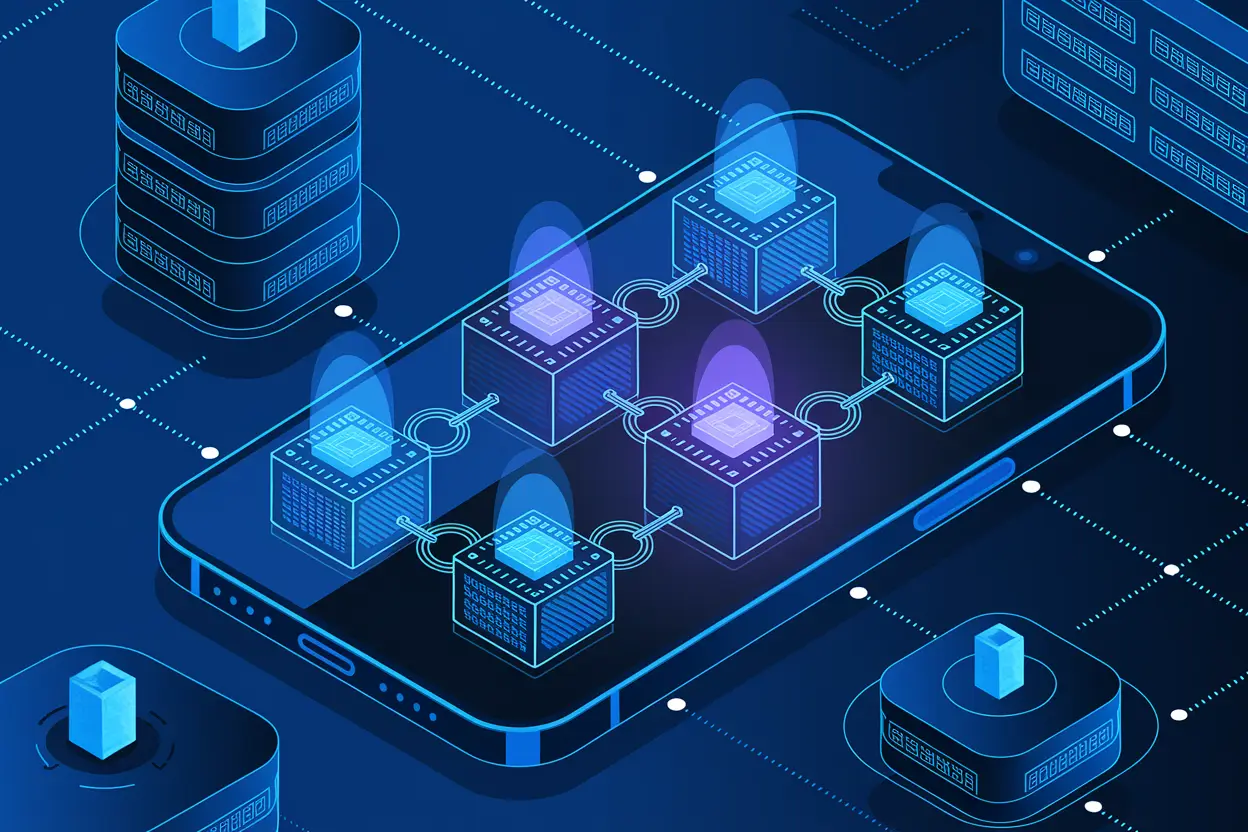Blockchain in Mobile Applications is revolutionizing how developers build, secure, and deploy digital solutions. As the demand for transparency, decentralized systems, and data integrity rises, blockchain has emerged as a critical technology reshaping mobile application landscapes across industries.
What is Blockchain in Mobile Applications?
Blockchain in mobile applications refers to the integration of decentralized ledger technologies into the development and functionality of mobile apps. This integration ensures enhanced security, more transparent operations, and streamlined digital interactions. By eliminating the need for intermediaries, blockchain allows mobile apps to execute tasks like transactions, data storage, and identity verification more securely and efficiently.
How Blockchain in Mobile Applications Works
Understanding the inner workings of blockchain in mobile applications involves grasping several foundational components:
- Decentralized Architecture: Data is not stored on a single server but across multiple nodes, increasing fault-tolerance and eliminating a single point of failure.
- Smart Contracts: These are code-run agreements that execute automatically once predefined conditions are met, removing dependence on central authorities for verifications.
- Cryptographic Verification: Each transaction is encrypted and linked to the previous one, ensuring tamper-proof registration and validation of activities.
Core Features of Blockchain in Mobile Applications
- Immutability: Data recorded on a blockchain cannot be altered, providing integrity for financial, personal, or transactional information.
- Transparency: All stakeholders can independently verify transactions and data flow, fostering trust among users.
- Decentralization: Removes dependencies on central platforms or governance, hence reducing vulnerability to cyber-attacks and misuse of power.
Advantages of Integrating Blockchain in Mobile Applications
- Increased Data Security: Blockchain makes hacking extremely difficult due to distributed nodes and encryption layers.
- Improved User Trust: With visibility into blockchain transactions, users are more likely to trust the app.
- Operational Cost Reduction: By eliminating intermediaries, smart contracts help lower processing and transactional costs.
Challenges of Using Blockchain in Mobile Applications
- Complexity in Development: Blockchain requires specific programming languages and can increase development timelines.
- Scalability Limitations: Some blockchain models have slower processing speeds as network size grows.
- Legal Framework: Inconsistent and unclear global regulations present compliance issues for app developers using blockchain technology.
Popular Use Cases for Blockchain in Mobile Applications
- Cryptocurrency Wallets and Exchanges: Apps like Binance or Coinbase allow users to send, receive, and trade digital assets securely.
- Healthcare Records Management: Patientory ensures user-driven control over sensitive health data.
- Supply Chain Tracking: IBM Food Trust uses blockchain-enabled mobile apps to trace product origins and distributions, enhancing food safety and provenance.
- Identity Verification: Civic enables secure ID authentication directly through users’ mobile devices.
Latest Trends in Blockchain in Mobile Applications
- Integration with AI: App developers are combining AI with blockchain for predictive analytics and fraud detection.
- Shift to Web3 Models: Web3-based mobile apps grant more autonomy to users while minimizing the influence of centralized corporations.
- Stablecoins and CBDCs: Government-supported digital currencies and stablecoins are now becoming integral to financial transactions through mobile apps.
Technical Guidelines for Building Blockchain in Mobile Applications
- Platform Selection: Developers must choose the right blockchain based on scalability, cost, and consensus mechanism. Ethereum supports smart contracts, while Hyperledger suits enterprise apps.
- Consensus Model Optimization: Use models like Proof-of-Stake or Delegated Proof-of-Stake for energy efficiency and scalability in mobile environments.
- Efficient Data Storage: Design apps to avoid storing large files on-chain. Instead, store data off-chain and reference it with hashes.
- Compliance Monitoring: Continuously track global regulations for privacy, especially GDPR, HIPAA, and FinCEN guidelines based on the app’s features.

In a typical mobile app environment, traditional databases store user data on centralized servers, exposing the system to hacks and data loss. When blockchain is integrated, user data resides across a peer-to-peer network. This architectural shift results in stronger security, lower latency in transactions, and tamper-proof records—making it ideal for high-trust applications such as banking or healthcare.
Blockchain in Mobile Applications Vs. Centralized Databases
| Feature | Blockchain | Centralized DB |
|---|---|---|
| Data Storage | Distributed across multiple nodes | Stored on a central server |
| Security | Cryptographically secured | Vulnerable to breaches |
| Cost | Lower operational costs | Includes intermediary charges |
| Scalability | Can be slower | Faster by default |
Real-World Example: Blockchain in Voting Mobile Applications
Voatz is a mobile voting app leveraging blockchain for secure and transparent electoral processes. It records each vote as an immutable ledger entry, visible to both users and election supervisors. The platform ensures every ballot is tamper-proof, verifiable, and secure—demonstrating blockchain’s practical impact.
Future of Blockchain in Mobile Applications
As businesses push for more efficient and secure app environments, the future of blockchain in mobile applications looks promising. Blockchain scalability is improving with solutions like sharding, rollups, and Layer 2 protocols. Interoperability between chains is pushing cross-platform development. Users can expect seamless experiences while maintaining data control and transaction efficiency.
Common Mistakes While Implementing Blockchain in Mobile Applications
- Storing Everything On-Chain: Leads to inefficiency and high-storage costs; use off-chain methods when possible.
- Ignoring User Experience: Blockchain’s complexity can overwhelm users if not abstracted with clean and intuitive UIs.
- Neglecting Regulatory Compliance: Apps handling sensitive data or handling payments must integrate region-based legal checks.
Best Practices to Integrate Blockchain in Mobile Applications
- Use SDKs like Moralis or web3.js to bridge blockchain and mobile infrastructure.
- Incorporate biometric authentication for added security in blockchain transactions.
- Design with scalability in mind—implement features using modular architecture.
Frequently Asked Questions about Blockchain in Mobile Applications
Why should developers consider blockchain in mobile app development?
Blockchain provides enhanced security, data integrity, and user transparency, making it ideal for apps in finance, identity, and more.
Can blockchain slow down app performance?
Yes, but optimizing the consensus mechanism and limiting on-chain operations can mitigate this.
Is blockchain suitable for all mobile applications?
No. Apps with low-transaction needs or no data-critical processes may perform better with traditional databases.
How do smart contracts benefit mobile apps?
Smart contracts automate and validate operations without intermediaries, reducing manual errors and processing delays.
What skills are needed to build blockchain mobile apps?
Developers need familiarity with decentralized systems, blockchain SDKs, smart contract programming (Solidity, Rust), and mobile development tools like React Native or Flutter.
Conclusion: The Power of Blockchain in Mobile Applications
Blockchain in mobile applications is no longer a futuristic concept—it’s a present-day solution improving security, transparency, and autonomy in app design. While it presents challenges like development complexity and scalability limitations, its benefits in privacy, integrity, and cost-efficiency far outweigh the drawbacks. As technologies mature, particularly in interoperability and usability, blockchain stands out as a cornerstone for next-gen mobile app ecosystems.



